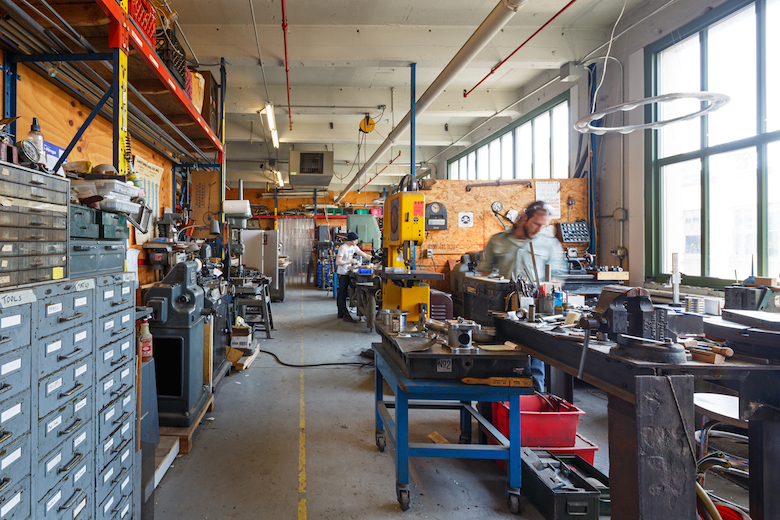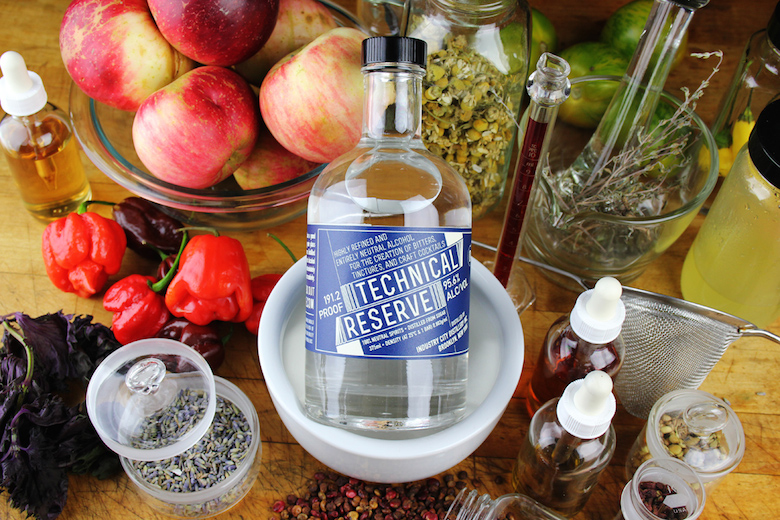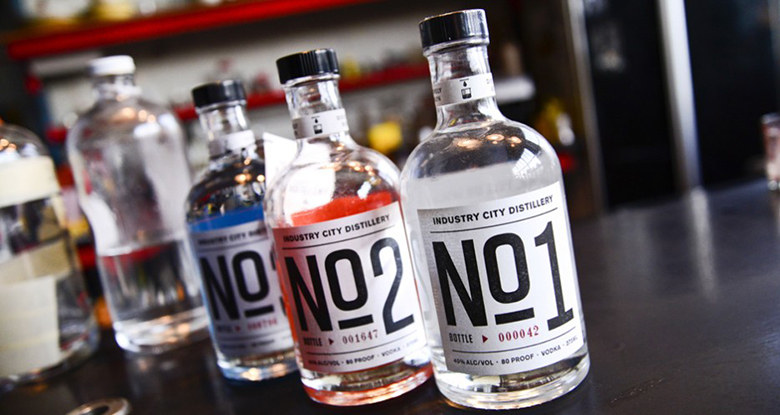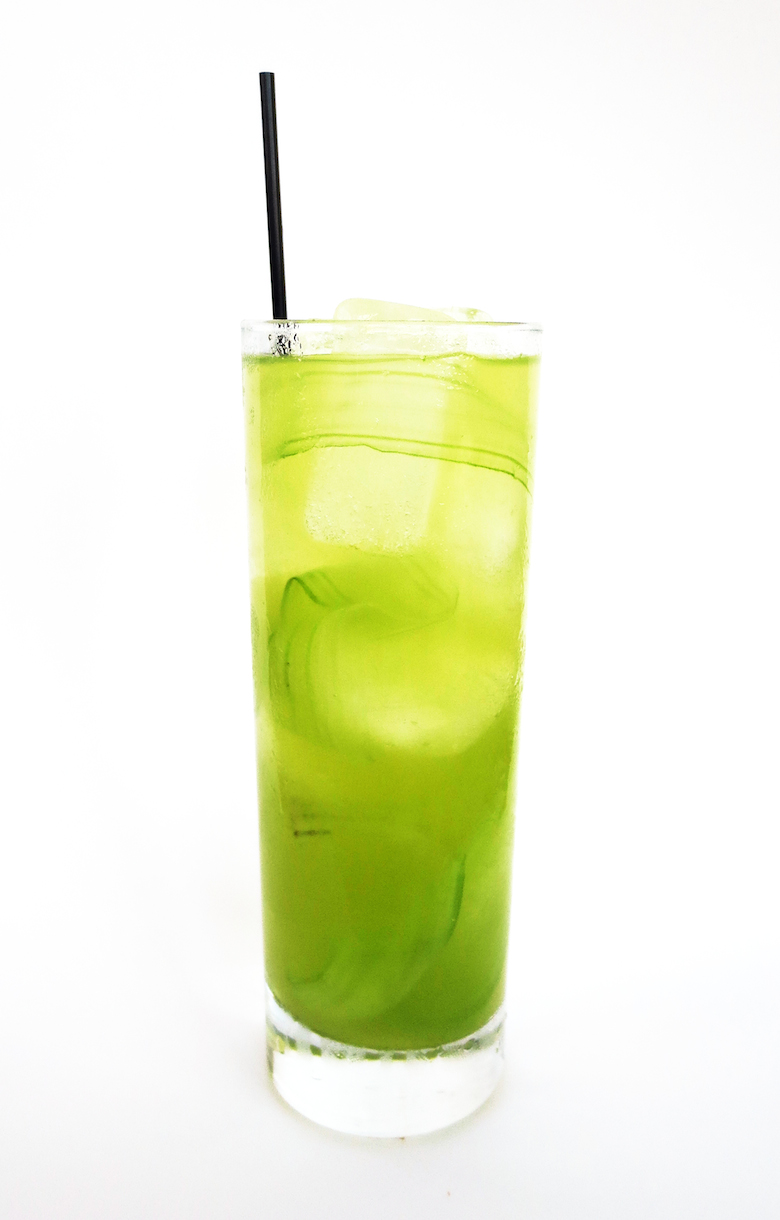Cool and Clear
The forecast for Industry Standard of Vodka is good.
“I’m actually a scotch and beer drinker,” says Dave Kyrejko, co-founder of Industry City Distillery and the maker of Industry Standard Vodka “A lot of people are like, ‘Why the hell did you make vodka? What is wrong with you? This is Brooklyn—you’re supposed to wear flannel and drink really horrible moonshine.’”
 Kyrejko and his partner, Zac Bruner, do make vodka—in Brooklyn’s Sunset Park, at Industry City’s manufacturing complex. The space is 12,000 square feet, perfect for hulking fermenting vats and distilling equipment. Yet the distillery itself occupies just 2,000 square feet: Fermenting occurs, precisely and quietly, in a closet-sized space featuring two elegant glass bioreactors. This suggests the care going into this Brooklyn-made craft vodka, created with homegrown French sugar beet yeast. If it sounds unusual, it is—from the mad-scientist laboratory where said yeast is carefully harvested to the final process of hand selecting and blending the vodka from a choice of thirty “cuts”.
Kyrejko and his partner, Zac Bruner, do make vodka—in Brooklyn’s Sunset Park, at Industry City’s manufacturing complex. The space is 12,000 square feet, perfect for hulking fermenting vats and distilling equipment. Yet the distillery itself occupies just 2,000 square feet: Fermenting occurs, precisely and quietly, in a closet-sized space featuring two elegant glass bioreactors. This suggests the care going into this Brooklyn-made craft vodka, created with homegrown French sugar beet yeast. If it sounds unusual, it is—from the mad-scientist laboratory where said yeast is carefully harvested to the final process of hand selecting and blending the vodka from a choice of thirty “cuts”.
 Hand-cultivating and harvesting yeast is unusual in commercial vodka making; running it through a centrifuge, then melding it with alginate to create yeast “beads,” is exceptional. There’s a method to the madness, though: Yeast beads ferment the water and sugar base in just 24 hours, ten times faster than when the same process is performed with regular yeast. The finishing process is similarly innovative. Most commercial and craft distilleries produce three fractions, or “cuts,” of vodka; the final product usually comes from the middle, or “heart,” cut. The 30-cut approach of Industry Standard separates the distilled alcohol into 30 separate fractions, with each evaluated for its flavor, texture, and smell. Selected cuts go into the final product; the rest is recycled.
Hand-cultivating and harvesting yeast is unusual in commercial vodka making; running it through a centrifuge, then melding it with alginate to create yeast “beads,” is exceptional. There’s a method to the madness, though: Yeast beads ferment the water and sugar base in just 24 hours, ten times faster than when the same process is performed with regular yeast. The finishing process is similarly innovative. Most commercial and craft distilleries produce three fractions, or “cuts,” of vodka; the final product usually comes from the middle, or “heart,” cut. The 30-cut approach of Industry Standard separates the distilled alcohol into 30 separate fractions, with each evaluated for its flavor, texture, and smell. Selected cuts go into the final product; the rest is recycled.
“Hand-cultivating and harvesting yeast;
running it through a centrifuge, then melding it
with alginate to create yeast “beads,”
is exceptional.”
________
Still, no matter how artisanal the approach, the image problem resists. “I imagine vodka conjures up a specific image for you, of parties and rooftops or whatever,” Bruner says. “And that’s unfortunately not too far from the truth. It’s not really a world that Dave or I really thrive in. But there’s a lot of stuff about making vodka—the art, craft, and science—that is really cool.”
 There are several reasons they’re making vodka, but one is this: to help fund Kyrejko’s other company, The City Foundry, a not-for-profit research and design group focused on improving small-scale manufacturing through science and art. “The City Foundry was established to find a way to combine science and art projects with likeminded people,” he says. “The distillery is our first project and a great one, because it combines everything that we wanted to do. You needed physics, chemistry, biology, manufacturing, marketing, graphic design—the list goes on.” The money from the distillery helps fund The City Foundry’s other science and art endeavors, with the entire system operating, as Kyrejko puts it, “as a non-for-profit using a for-profit entity.”Although each has his specialties—Kyrejko runs the lab, Bruner the shop—they work in tandem to create smart distilling solutions that illustrate City Foundry’s mission of better manufacturing through innovation. They’ve developed a stainless-steel, steam-powered distilling machine to reduce energy consumption and repurposed remnant alcohol as sterilizer for the lab.
There are several reasons they’re making vodka, but one is this: to help fund Kyrejko’s other company, The City Foundry, a not-for-profit research and design group focused on improving small-scale manufacturing through science and art. “The City Foundry was established to find a way to combine science and art projects with likeminded people,” he says. “The distillery is our first project and a great one, because it combines everything that we wanted to do. You needed physics, chemistry, biology, manufacturing, marketing, graphic design—the list goes on.” The money from the distillery helps fund The City Foundry’s other science and art endeavors, with the entire system operating, as Kyrejko puts it, “as a non-for-profit using a for-profit entity.”Although each has his specialties—Kyrejko runs the lab, Bruner the shop—they work in tandem to create smart distilling solutions that illustrate City Foundry’s mission of better manufacturing through innovation. They’ve developed a stainless-steel, steam-powered distilling machine to reduce energy consumption and repurposed remnant alcohol as sterilizer for the lab.
“When our vodka hits seltzer water,
it releases all of those fruity esters that the yeast makes.
Now I’m a convert.”
________
Industry Standard Vodka is so good that it has won over its two most discerning critics: its creators. When asked how he enjoys his vodka, Kyrejko smiles. “I used to poo-poo vodka and soda—that was never a drink I enjoyed. But when our vodka hits seltzer water, it releases all of those fruity esters that the yeast makes. Now I’m a convert.”All that science wouldn’t matter if their vodka isn’t a great product—and it is. It has a smooth and flavor-filled profile, with notes of vanilla and fruit. Better yet, it’s free from the astringent and harsh aftereffects associated with those rooftop parties. As we tentatively take a sip, Kyrejko notes, “You’ll notice it doesn’t even burn into your stomach. There’s no need to exhale or cough.” He’s right.
Kryejko’s favorite recipes for Industry Standard Vodka
The Sunset Stalker
“I developed this drink as an alternative to sweet drinks for the summer. Celery has a lot of minerality to it that makes for a savory sweetness without all of the sugar.”
1.5 oz Industry Standard Vodka
1 oz freshly juiced celery
Dash of anise liqueur like Herbsaint, absinthe, or pastis
A celery ribbon for garnish** or even chopped celery stalk
Combine Industry Standard Vodka, fresh celery juice, and anise in a cocktail shaker, fill with ice and give a quick shake. Take your cocktail glass, coil the celery ribbon into the glass and fill with ice, wedging the ribbon to the inside of the glass.
Double-strain the contents of the cocktail shaker into the garnished cocktail glass and serve.
________
The Back Beet
“This is a drink that was made specifically to play the sweet and sour beet juice against the natural sweetness of the Industry Standard.”
2 oz Industry Standard Vodka
1/4 oz dry white vermouth
1/2 oz picked beet juice (we love Clinton Hill Pickles if you don’t want to make your own)
A sliver or slice of raw beet for garnish
Fill a shaker tin with ice, add Industry Standard Vodka and vermouth. Stir for at least 30 seconds. Strain shaker into coup or martini glass and gently add your beet brine (it will sink perfectly to the bottom if you are careful). Finally, place your beet garnish at the bottom. The layers of this drink really let you experience the vodka and play with adding the beet flavor to the drink.
________
Mick the Miller
“Named for the world’s most famous greyhound, Mick the Miller is a playful, refreshing take on the classic Greyhound.”
1.5 oz Industry Standard Vodka
2 oz demi-sec grapefruit soda (San Pellegrino Pompelmo, Squirt!, or KISS soda)
2-3 thyme sprigs
Place thyme sprigs into your collins or rocks glass. Fill with ice and pour in the vodka. Fill with grapefruit soda. To really get the most out of the thyme, you can place the sprigs with the stem side up so that the flavorful leaves come in contact with the vodka as much as possible.
Find the perfect glassware for your vodka cocktails on DARA Artisans.


